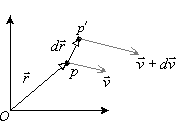

While the motion of individual points of fluid tells us things like the force on the fluid at that point, in order to understand effects such as viscosity we must look at deformation of the fluid. The local deformation of the fluid near some point P depends on how arbitrary neigboring points P' move compared to P. If all neighboring points P' move with the same velocity as P, the fluid moves as a solid block, and there is no deformation.
The motion of point P' relative to neighboring point P is
given by the difference in velocity ![]() .
.
![]()
To understand this better, take A apart into symmetric and antisymmetric parts:
![]()
The symmetric part is called the strain-rate tensor.


The trace of the tensor S is the rate of (relative volume) expansion of the fluid.
The second, antisymmetric, part of A looks as:

![]()
Vorticity is important because it allows flows to behave in complicated, nonlinear ways.
The line integral of the velocity along a closed contour is called the
circulation ![]() of that contour:
of that contour:

Exercise:
What can you say aboutif
?